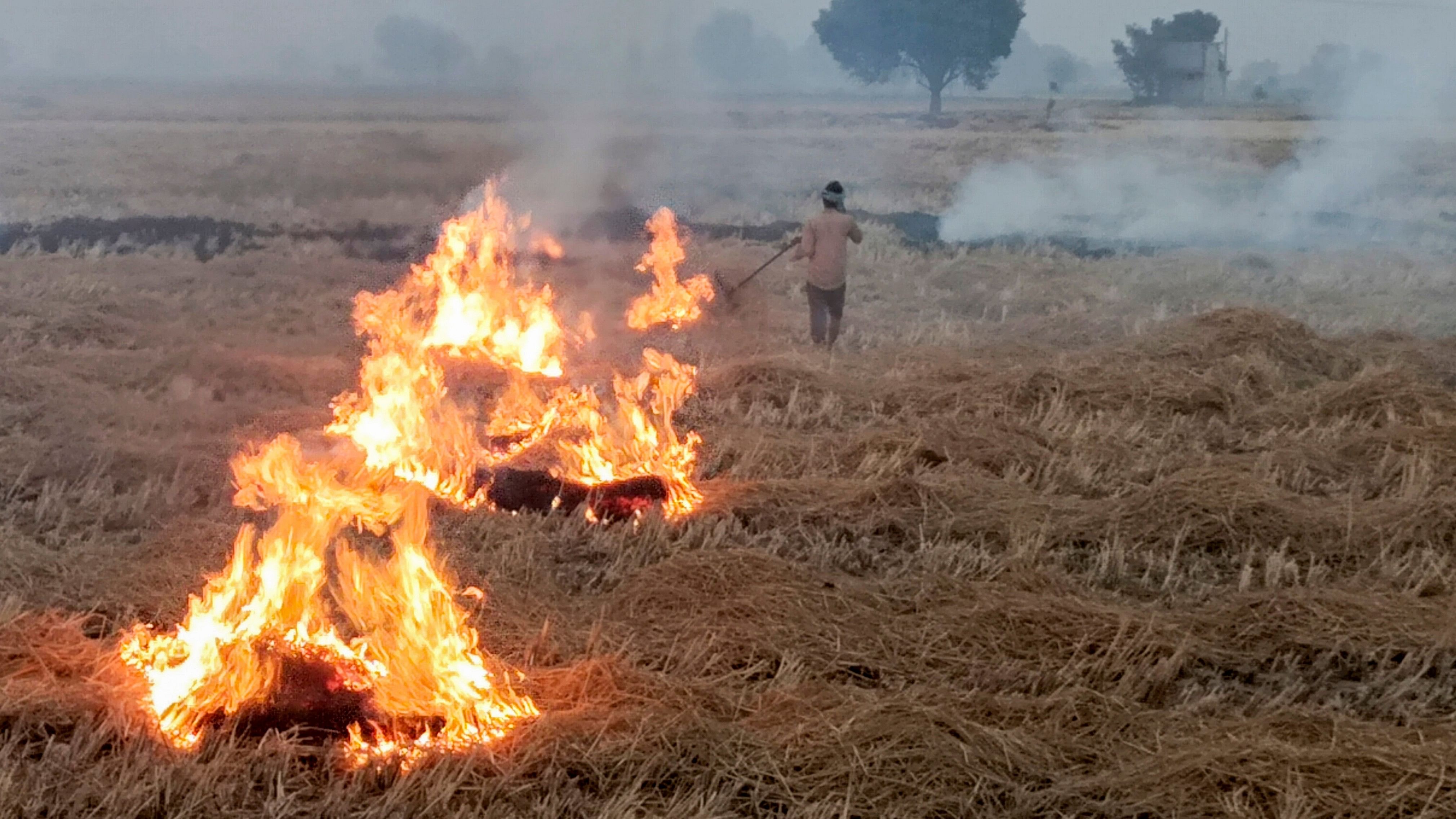
A farmer burns paddy stubbles at a field on the outskirts of Amritsar,
Credit: PTI Photo
For eight years, Delhi’s pollution levels have been a major concern, worsening each winter as stagnant air traps pollutants near the ground, creating harmful smog all around. This leads to breathing difficulties and health hazards. Traditionally, the air quality index (AQI) in Delhi NCR spikes after Diwali. This year, people did not pay heed to the fire cracker ban. Still, AQI levels did not worsen as much due to unusually warm weather; the India Meteorological Department confirmed that India had the warmest October this year, breaking the 1951 record. However, pre-Diwali AQI was 386 and air quality was already in the ‘very bad’ category. Post-2023-24 winter, Delhi was adjudged the most polluted capital city. The average AQI between October 1, 2023, and February 29, 2024, was 304, a notable increase from 280 in 2022–2023 and 278 in 2021–2022. The IMD has also warned that La Nina—a phenomenon associated with cooling in the eastern equatorial Pacific—has yet to develop, meaning there will be no immediate respite for the region.
Vehicular emissions, construction dust, cola and wood burning for cooking, industrial activities, and stubble burning in Haryana, Punjab, and parts of Uttar Pradesh and Rajasthan are the main contributors to Delhi’s pollution. While stubble burning is seasonal, the other sources persist year-round. Studies show that stubble burning contributes less than 10%, vehicular pollution 20%, industries 15%, and road dust over 40% of pollutants. Accordingly, the Delhi government has imposed several restrictions, including restricting heavy vehicle entry, halting or staggering construction, promoting CNG and electric vehicles, enforcing an odd and even rule for vehicles on the roads, sprinkling water to control dust, closing polluting industries, and shutting down schools when AQI spikes.
Cloud seeding has been explored as an option to reduce pollution, but it relies on moisture-laden clouds, which are scarce during dry winters. When the conditions are met, silver iodide, present in the atmosphere in lower concentrations, is additionally injected from aircraft to increase the concentration. Ice crystals are thus formed, causing artificial rains. As La Nina has yet to develop, the weather pattern is not appropriate for cloud seeding.
Many urban households still use coal and wood for cooking, though the Ujjawala Scheme has reached out to rural areas and provided free and/or subsidised LNG gas connections and cylinders. Why is a similar scheme not rolled out for the section of households not using clean fuel for cooking in Delhi and adjoining areas? There should be regulation for industries to operate on clean fuel and also make sure that their gaseous emission is through electrostatic precipitators and liquid discharge through sewage treatment plants. If pollution control measures are truly in place, industrial pollution should be much lower than 15%. There is a need for compliance.
About a year ago, Oxfam International’s report, Climate Equality: A Planet for 99%, highlighted the outsized impact of emissions by the super-rich, who, with their massive investments in polluting industries and extravagant lifestyles, contribute as much to emissions as the bottom half of the global population.
SUVs, which emit 20% more than mid-sized cars, are 48% of the cars sold globally, consuming an estimated 600,000 barrels of oil per day in 2022 and 2023. It is a quarter of annual growth in oil demand. SUVs emit 20% more than midsized cars. Restricting use of SUVs in Delhi from October to January each year till they transition away from fossil fuels. However, merely shifting to electric vehicles may not be sufficient if they are charged using coal-generated electricity.
The Supreme Court is also engaged in dealing with pollution in the national capital region and has been issuing directions from time to time. The Commission for Air Quality Management (CAQM) is also active in coordinating with agencies and taking action to book the offenders responsible for causing pollution as well as officers of state and central governments for inaction. The Supreme Court recently reiterated that it is the fundamental right of all citizens to live in a pollution-free environment, and it is the responsibility of the governments to ensure that. The Court ordered to increase the penalty amount for causing pollution. The court further observed that CAQM is issuing notices instead of prosecuting officers for inaction, and also that the central government has not framed rules for penalising the offenders for burning the stubble on farmland. As the Supreme Court has expressed anguish, officers are chasing agriculturists for farm fires.
After harvesting paddy crops, farmers have limited time to prepare for the rabi season, making it challenging to cut the straw only two to three inches above the ground, thereby not leaving enough stubble on the farm. While it is good to make the farmers aware, it is necessary to modify the harvester. Criminalisation of the act is not desirable as they are our ‘annadatas’. Why not target SUV owners before targeting farmers?
Delhi has ample space for tree planting, which could help settle dust and sequester carbon. Trees absorb CO2 to make their food in the presence of sunlight (through photosynthesis), a process essential for improving air quality. It is distressing to note that with the permission from Delhi’s LG V K Saxena, 642 trees were cut in the Ridge area in February 2024 for providing road connectivity to a super speciality hospital, reportedly without the Supreme Court’s approval -- a decision that warrants accountability and investigation and should be hauled up in the contempt case.
(The writer is a retired principal chief conservator of forests, Karnataka)